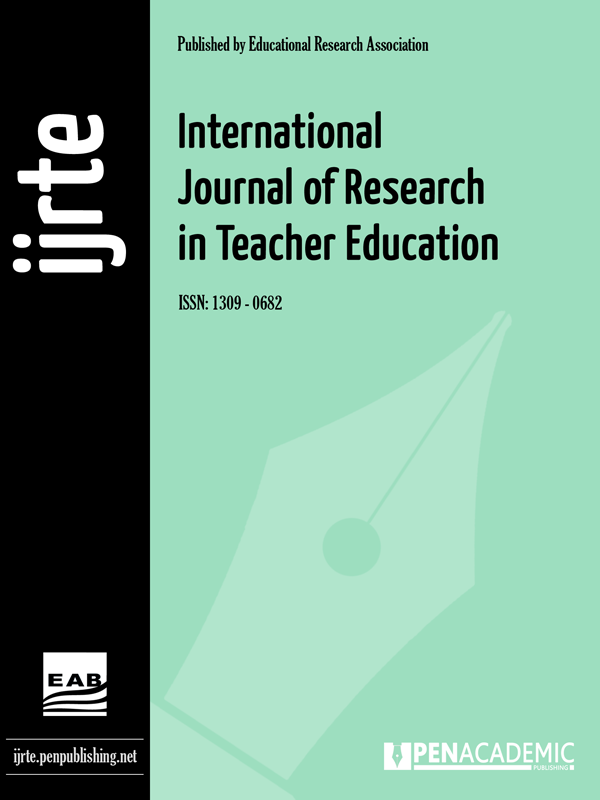Original article | International Journal of Research in Teacher Education 2023, Vol. 14(3) 56-68
Emotional Intelligence Dimensions Scale (EIDS); A Study of Scale Development
Zafer Güney, Yiğit Ege Güney & Seray Topçu
pp. 56 - 68 | DOI: https://doi.org/10.29329/ijrte.2023.598.05 | Manu. Number: MANU-2308-31-0006
Published online: September 27, 2023 | Number of Views: 22 | Number of Download: 138
Abstract
The purpose of this research is to develop a valid and reliable scale of emotional intelligence dimensions. Before starting the scale development process, a comprehensive item pool was designed for the scale items by reviewing the literature in the first stage. In the second stage, content validity was examined by field experts' evaluations of the items. The scale prepared with 18 items was applied to the study group consisting of 358 people and validity and reliability analyses were conducted. The data collected in the study were analysed with Amos 22 and SPSS 20 application programs. Exploratory factor analysis (EFA), confirmatory factor analysis (CFA) and reliability analyses were conducted for the construct validity analysis of the EIDS and reported.
Within the scope of EFA analysis, Kaiser- Meyer-Olkin (KMO) coefficient 0.839 (p = .000) and Bartlett's Test of Sphericity was significant at p< .01. As a result of the EFA analysis, it was determined that the scale, which was transformed into 14 items, had a structure consisting of three sub-factors explained as adaptation to the environment, managing emotions and problem solving. These factors were found to explain 59.71% of the total variance. As a result of the item analysis phase carried out to reveal the discrimination levels of the items prepared for the EIDS, it was seen that the difference between the items was significant at p< .01 level. Cronbach's alpha reliability coefficient was found to be 0.875 for the EIDS prepared in the study. With CFA, the scale consisting of 10 statements with 3 sub-dimensions can be called valid and reliable.
Keywords: Emotional intelligence dimensions, problem solving, scale development.
| How to Cite this Article? |
|---|
|
APA 6th edition Harvard Chicago 16th edition |
| References |
|---|
|
Anderson, J. C., & Gerbing, D. W. (1984). The effect of sampling error on convergence, improper solutions, and goodness-of-fit indices for maximum likelihood confirmatory factor analysis. Psychometrika, 49(2), 155-173 Baltaş, Z. & Baltaş, A. (2005). Bedenin Dili, (37th Edition), Remzi Bookstore, İstanbul. Bar-On, R. (1997). BarOn emotional quotient inventory (Vol. 40). Multi-health systems. Bryman, A. and Cramer, D. (2011). Quantitative data analysis with IBM SPSS 17, 18 and 19. Hove: Routledge. Bryne, B. M. (2001), Structural equation modeling with AMOS Mahwah, NJ: Lawrence Erlbaum Associates. Büyüköztürk, Ş. (2002). Faktör analizi: temel kavramlar ve ölçek geliştirmede kullanımı. Kuram ve Uygulamada Eğitim Yönetimi. 32, 470-483. Büyüköztürk, Ş., Cakmak, K. C., Akgün, E., Karadeniz, Ş. & Demirel, F. (2015). Bilimsel Araştırma yöntemleri (19th Edition). Ankara: Pegem Publishing. Büyüköztürk Ş. (2011). Sosyal Bilimler İçin Veri Analizi El Kitabı: İstatistik, Araştırma Deseni SPSS Uygulamaları ve Yorum, Pegem Publishing, pg 216, Ankara. Can, A. (2014). SPSS ile bilimsel araştırma sürecinde nicel veri analizi. Ankara: Pegem Publishing. Çokluk, Ö., Şekercioğlu, G. & Büyüköztürk, Ş. (2014). Sosyal bilimler için çok değişkenli istatistik spss ve lisrel uygulamaları. Ankara: Pegem Publishing. Damasio, A. R. (1994). Descartes’ error. New York DeVellis, R. F. (2003). Scale development: Theory and application (6th Edition). Thousand Oaks, CA: SAGE. Erkuş, A. (2012). Psikolojide ölçme ve ölçek geliştirme. Ankara: Pegem Akademi Publishing. Field, A. (2009). Discovering Statistics Using SPSS. London: SAGE. Page 662. Fraenkel, J. R. & Wallen, N. E. (2003). How to design and evaluate research in education. The McGraw-Hill: New York. Gardner, H. (1999). Çoklu Zeka (Translated by M.Tüzel) BZD Publishing, Enka Foundation, Istanbul. George D, & Mallery P. (2003). SPSS for Windows step by step: A simple guide and reference. 11.0 update (4th ed.). Boston: Allyn & Bacon. Goleman, D. (1996). Duygusal Zekâ İstanbul: Varlık Publishing. Gönül, T. & Geçikli, F. (2023). “Bir Büyükşehir Belediyesinde Çalışanların Duygusal Zekâ Yetkinlikleri ve Çatışma Algıları”, International Social Mentality and Researcher Thinkers Journal, doi:10.29228/smryj.68225 Hu, L. T., & Bentler, P. M. (1995). Evaluating model fit. In R. H. Hoyle (Ed.), Structurale quation modeling: Concepts, issues, and applications. (page 76-99). Thousand Oaks, CA: Sage. Karagöz, Y. (2016). Spss ve Amos23 uygulamalı istatistiksel analizler. Ankara: Nobel Publishing. Kelloway, E. K., (1998), Using LISREL for Structural equation modeling, Thousand Oaks, CA: Sage Publishers. Kotsou I., Mikolajczak M., Heeren A., Grégoire J., Leys C. (2018).” Improving Emotional Intelligence: A Systematic”, Emotion Review, 11(2),151-165. https://doi.org/10.1177/1754073917735902. Lawshe, C. H. (1975). “A quantitative approach to content validity.” Personnel Psychology, 28, 563–575 Mayer, J. D., & Salovey, P. (1990). Emotional intelligence. Imagination, Cognition, and Personality,9, 185-211. Mayer, J. D., Caruso, D. R., & Salovey, P. (1997). Emotional intelligence meets. Schermelleh-Engel, K., Moosbrugger, H., & Müler, H. (2003). Evaluating the fit of structural equation models: tests of significance and descriptive goodness-of-fit measures. Methods of Psychological Research Online, 8(2), 23-74. Shapiro, L. E. (2002). Yüksek EQ’lu bir çocuk yetiştirmek (Translated by Ü. Kartal). İstanbul: Varlık Publishing. Steven, S. ve Book, J, H.(2003). Duygusal Zekâ ve Başarının Sırrı. (Translated by Müjde Işık) İstanbul: Özgür Publishing. Tavşancıl, E. (2002). Tutumların ölçülmesi ve SPSS ile veri analizi. Nobel Publishing. Veneziano, L. & Hooper, J. (1997). A method for quantifying content validity of health-related questionnaires. American Journal of Health Behavior, 21(1), 67-70.
|


